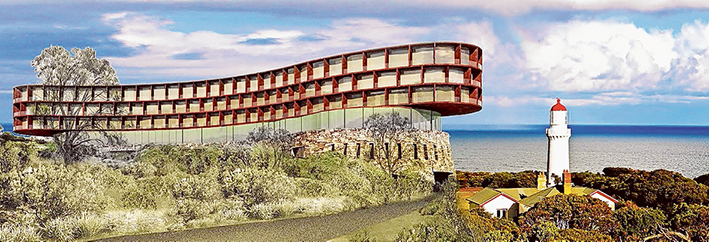
OPPONENTS of the RACV’s proposed $135 million resort at Cape Schanck are using image warfare and the internet to win converts and keep pressure on decision-makers.
The latest tactic is an internet survey that allows comments both for and against the controversial development that will rise five storeys – almost 30 metres – and accommodate 650 conference delegates, up from the existing 250 limit.
A pamphlet promoting the six-question survey includes an arresting image of the proposed resort dwarfing Cape Schanck’s iconic lighthouse.
The new anti-resort push comes as the issue gained complexity following an abandoned meeting of Mornington Peninsula Shire councillors last month. Councillors had been set to approve the resort mid-May but got cold feet over potential conflict of interest as most of the 11 councillors are members of the RACV (“Conflict call puts brakes on resort”, The News, 26/5/15).
The shire asked Local Government Minister Natalie Hutchins to rule on the potential conflict and The News understands a report was due on 5 June but a decision had not been made by last Friday.
The resort application was on the council agenda of 22 June but was withdrawn and is likely to be debated at a council meeting in July, assuming the conflict matter is resolved.
Objectors have been lobbying Nepean state MP Martin Dixon, who last month was critical of councillors for baulking at voting on the resort, and also criticised the council for dumping its planning committee in favour of bringing important planning matters to full council meetings.
“The nonsense at council over the past few weeks is only helping them avoid their responsibility to vote,” he told one objector.
“I will be finalising my letter to both the Planning Minister and the Local Government Minister … to express my deep concern at what can only be described as ‘amateur hour’ by the Mornington Peninsula Shire Council.”
The News understands that Mr Dixon, under pressure from objectors, suggested to the RACV that it lower the resort by setting about 3.5 metres into the ground but this was rejected.
Objectors also have lobbied the state Opposition’s planning and local government spokesman David Davis, who has been showing an increased interest in peninsula affairs in recent months.
Ian Renwick of Friends of Cape Schanck, one of several groups in a loose alliance opposing the project, said Mornington Peninsula Shire had asked the RACV to “erect height poles to provide residents and councillors with a clear indication of the scale of the proposed building to assist in their planning approval process” but the RACV said this was too complicated.
“The RACV and its consultants Tract tried to show the height with blue party balloons one midweek afternoon but couldn’t get them high enough due to the wind,” he said.
“So we were left to think of other ways to try and comprehend what the RACV has planned, and came up with the photo montage. The lighthouse is 21 metres high compared to the proposed redevelopment at 31 metres.”
Objectors have taken to calling the proposed resort the “mothership” or “Ayers Rock”, and it is the bulk of the building that has upset many people. Many locals supported the concept initially but then saw plans for the huge building and changed their minds.
Mr Renwick said the top of the proposed resort would be 45 metres higher than the lighthouse, and would be seen from far out to sea. “Perhaps the RACV’s resorts at Torquay and Cape Schanck can signal each other,” he said with tongue in cheek.
He said some objectors were concerned the RACV would repeat the tactics used at Torquay where the organisation won council approval for four storeys but then went to the Victorian Civil and Administrative Tribunal in 2010 and won approval for a fifth storey, taking the building on golf club land from 16 to 19.6 metres high. At Cape Schanck, the RACV is allowed to erect a 160-room resort but has said it will build a 120-room complex.
As of Friday, 154 people had completed the survey, with 93 per cent (143) not supporting the proposal. About 42 per cent described themselves as non-Cape Schanck residents, 40 per cent as permanent and 12 per cent part-timers.
First published in the Southern Peninsula News – 16 June 2015


